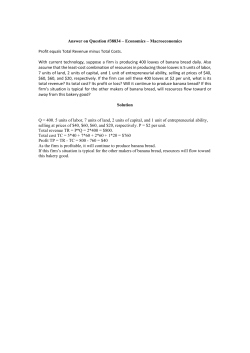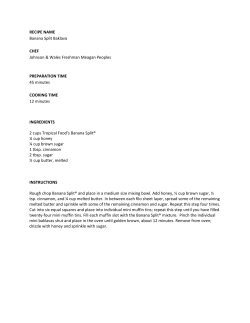
How to make a banana milkshake - E
Name: Discuss this with a friend before listening to the instructions: What information do you expect to hear in this listening skill? Have you made a banana milkshake before? How do you think you would go about it? Listen as your teacher reads the following information to you. Use a piece of paper to draw pictures only as notes. You will need 250mℓ milk, 1 banana, 1 egg, 2 scoops of ice-cream, a jug, a glass, a fork, a bowl. Method 1. Pour the 250mℓ milk into the jug. 2. Break the egg into the milk. 3. Peel the banana and mash it with a fork in the bowl. Add the banana to the milk. 4. Add 2 scoops of ice cream. 5. Beat the mixture with the fork until it is smooth. 6. Pour the mixture into the glass. 7. Enjoy your milkshake! Don’t forget to clean up the mess afterwards! © e-classroom 2015 www.e-classroom.co.za GRADE 6 Grade 6 English Home Language Term 2 Weeks 1&2: Unit “How do you do it?”: Listening and Speaking: Listens to and discusses an instructional text PG2&3 How to make a banana milkshake After you have listened, discuss with a friend: a)What did you like about this procedural text and what didn’t you like about it? b)Did you notice the imperative verbs at the beginning of each sentence in the method? Recall some of them. c) In your opinion, what was the main message that came across? d)Can you visualise how this procedural text would be written? Work on your own: • Write down the recipe as you think it will look using your drawings to guide you. • Make sure you start with imperative or command verbs as you write each instruction. • Use key headings that you think a recipe should have. • Draw a picture of how you imagine the final banana milkshake to look like. • When you have finished, ask your teacher to show you the original recipe and compare yours with the original. Are they similar? Listening and speaking: Relate your own easy recipe to your friend Have you ever made something to eat that is really simple to make? • Tell your friend how you did it • Use imperative verbs as you recall the method you used (e.g. mix, beat, mash etc). • Work with another pair. Relate what your friend told you to the new pair. You can use words instead of numbers for the instructions (e.g. first, next, then etc.) © e-classroom 2015 www.e-classroom.co.za GRADE 6 Grade 6 English Home Language Term 2 Weeks 1&2: Unit “How do you do it?”: Listening and Speaking: Listens to and discusses an instructional text PG2&3 How to make a banana milkshake
© Copyright 2025



















